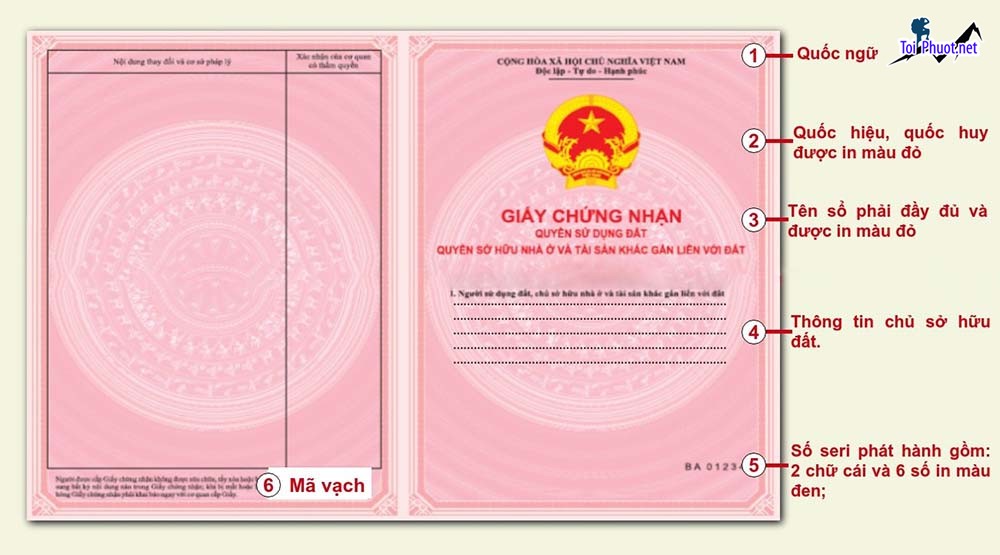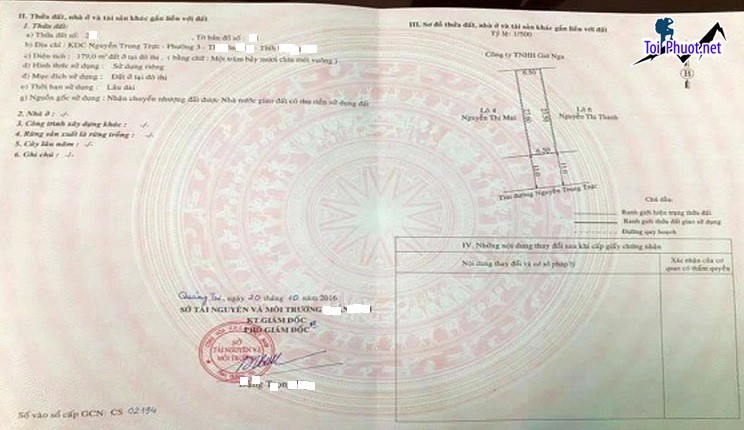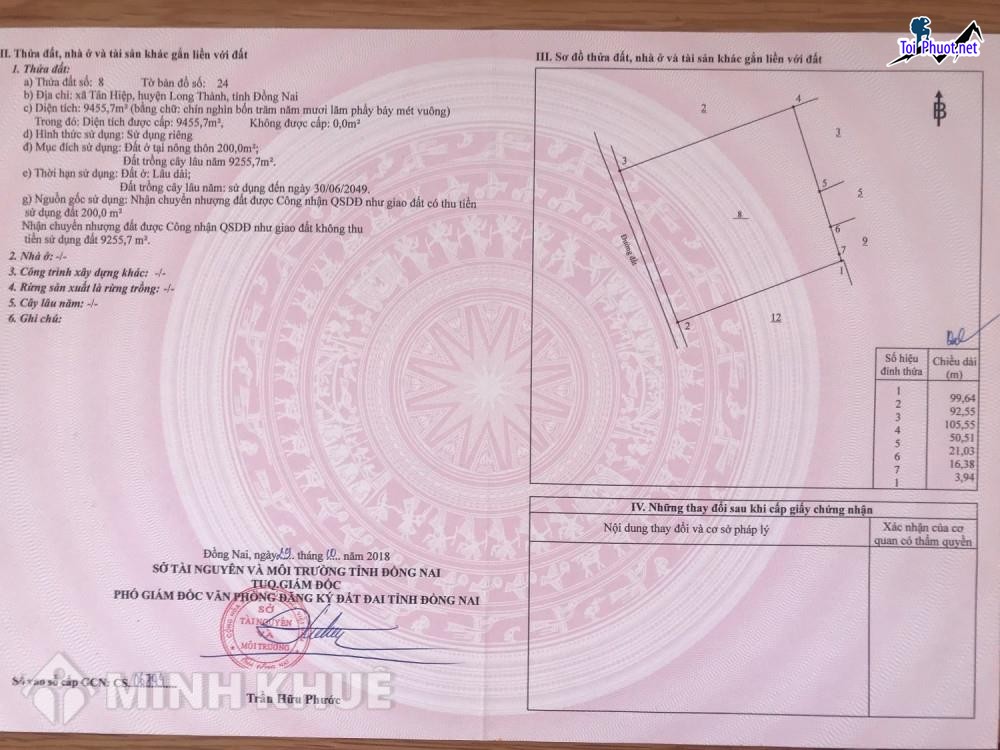
How to read the most complete and accurate pink book in the US Understanding how to read information on the Land Use Rights Certificate (“Red Book” or “Pink Book”) allows one to identify who holds the land use rights, the land area, its purpose, and whether it is mortgaged—thereby reducing legal risks when acquiring land.
“Red Book” and “Pink Book” are commonly used terms for the Certificate of Land Use Rights and Ownership of Land-Attached Assets. Before August 1, 2024, under the Land Law 45/2013/QH13, these terms referred collectively to the certificate verifying land use rights, residential ownership, and other assets attached to the land.
This information is recorded on page 1 of the Certificate.
If the land is registered under a single individual (not jointly owned by spouses), per Article 32(1) of Circular 10/2024/TT-BTNMT, the certificate lists:
How to read the most complete and accurate pink book in the US
“Mr.” or “Mrs.”, full name, type and number of personal ID.
If the user is a foreigner or a Vietnamese living abroad:
“Mr.” or “Mrs.”, full name, nationality, and the ID type and number.
Per Article 32(2), when usage rights are shared by spouses:
The certificate lists one spouse: “Mr.” or “Mrs.”, their ID details, followed by “husband (or wife): …” showing the other spouse’s details.
If both agree, it may state: “is the representative for both husband and wife.”
According to Article 32(3):
For domestic organizations: name, registration document type, number, issue date, and issuing authority.
Foreign-invested enterprises: details of investment or business registration certificates.
Foreign diplomatic entities: land allocation/rental documents issued by authorities or joint agreements.
Religious organizations: registration or recognition documents.
As per Article 32(4), the certificate lists the name of the community group if applicable.
Under Article 32(5), two cases:
Separate certificates: each lists the individual, followed by “jointly using land, jointly owning assets...” A QR code contains all joint users’ data.
Single certificate with representative: lists the representative and notes “as representative for joint users,” with a QR code showing all parties.

Article 32(6) details land used by a household:
Either each member is listed, or key members are listed followed by “and other household members as shown in the QR code.”
Under Article 32(7), if a person owns assets on land they do not use, their information is listed accordingly, following prior formats.
Also under Article 32(7):
Separate certificates: each heir is listed with “joint use/ownership” and a QR code capturing all heirs.
Single certificate with heir representative: lists the representative and states “representing the heirs,” with a QR code including them all.
Recorded on page 2 per Article 33. It includes:
Parcel number, map sheet number, address, area
Form and purpose of use
Term of use and origin of rights
Important details:
Per Article 8(5):
Exclusive use (“Sử dụng riêng”) if held by one entity.
Shared use (“Sử dụng chung”) if held by multiple entities.
Mixed cases list both exclusive and shared areas by size.
Apartment units are marked as “Shared use.”
Article 8(34) requires listing all land-use categories and their respective areas. If land has multiple categories or different state-assigned uses, all must be recorded with map codes.
Under Article 8(4):
For land allocated or leased by the State, duration matches the official decision ("Long-term" or a fixed expiry date).
For other cases, usage is listed similarly.
For unallocated land or where no expiry is set, it shows “Not determined.”
How to read the most complete and accurate pink book in the US
Recorded under section 3 of the certificate, based on Articles 34 and 10(1).
Detached houses are classified (villa, semi-detached, or standalone).
Project-built houses include project name.
Construction area, floor area, number of storeys, structure, building grade, and ownership term are recorded.
For condos, serviced apartments, offices, commercial units:
Name from sales agreement, building name (e.g. “Apartment 1001 – Tower CT1”).
Floor and usage areas, building grade.
Ownership form: private, shared, or both.
Term of ownership or lease expiry as per legal contract.
Common areas (“Shared corridor 150 m²; community room 80 m²”) are listed.
For non-residential structures:
Listed by project documentation with details on size, floors, structure, grade, and ownership term, or “-/-” if none.
If no assets exist or are unclaimed, entries show “-/-.”
Recorded as per Article 13:
For entire parcels: e.g. “Transferred to [Recipient Name] with file no. …”
For subdivided parcels: notes list new parcel numbers and relevant file references.
Per Article 13(24):
For pledge registration: “Mortgaged by … to [Bank Name] under file no. …”
For changes or removal: clearly documented with dates and file references.
How to read the most complete and accurate pink book in the US
By understanding how to read the Red Book/Pink Book, anyone can verify landholder identity, legal status, collateral information, and detect issues before property transfer—thus minimizing legal risk. If you need assistance with land or housing matters, please call 19006192 for support.
Nguồn tin: luatvietnam. vn
Những tin mới hơn
Những tin cũ hơn
 Cho Thuê Lều Du Lịch Giá Rẻ Ở Tại Phú Yên
Cho Thuê Lều Du Lịch Giá Rẻ Ở Tại Phú Yên
![[Flycam] Núi Đá Bia, điểm du lịch sinh thái ở Phú Yên](/assets/news/2016_10/nui-da-bia-diem-du-lich-sinh-thai-o-phu-yen13.jpg) [Flycam] Núi Đá Bia, điểm du lịch sinh thái ở Phú Yên
[Flycam] Núi Đá Bia, điểm du lịch sinh thái ở Phú Yên
 Ngẩn Ngơ Vẻ Đẹp Tinh Khôi Của Hot Girl Tú Linh Khi Diện Áo Cưới
Ngẩn Ngơ Vẻ Đẹp Tinh Khôi Của Hot Girl Tú Linh Khi Diện Áo Cưới
 Cho thuê loa kẹo kéo vali du lịch giá rẻ tại Tuy Hòa - Phú Yên
Cho thuê loa kẹo kéo vali du lịch giá rẻ tại Tuy Hòa - Phú Yên
 Spa ở tại Tuy Hòa Phú Yên bạn nên chọn để làm đẹp và chăm sóc da
Spa ở tại Tuy Hòa Phú Yên bạn nên chọn để làm đẹp và chăm sóc da
 Địa Điểm Chụp Ảnh Cưới Đẹp Ở Phú Yên
Địa Điểm Chụp Ảnh Cưới Đẹp Ở Phú Yên
 Thuê Xe Máy Tuy Hòa - Thuê Xe Máy Phú Yên Giá Rẻ
Thuê Xe Máy Tuy Hòa - Thuê Xe Máy Phú Yên Giá Rẻ
 Cây hoa đào, mai, liễu đèn led, thanh lý giá rẻ toàn quốc
Cây hoa đào, mai, liễu đèn led, thanh lý giá rẻ toàn quốc
 Áo cưới Phú Yên Sang Trọng Quyến Rũ
Áo cưới Phú Yên Sang Trọng Quyến Rũ
 Suối nước khoáng Phú Sen, điểm du lịch nghĩ dưỡng ở Phú Yên
Suối nước khoáng Phú Sen, điểm du lịch nghĩ dưỡng ở Phú Yên
 Top 9 Shop giày nữ đẹp được yêu thích nhất Hà Nội đa dạng loại mẫu
Top 9 Shop giày nữ đẹp được yêu thích nhất Hà Nội đa dạng loại mẫu
 Top 13 Shop giày nữ đẹp được yêu thích nhất Đà Nẵng tại đây
Top 13 Shop giày nữ đẹp được yêu thích nhất Đà Nẵng tại đây
 Top 10 Nhà sách lớn nhất Sài Gòn Hồ Chí Minh với những kiến thức cực hay
Top 10 Nhà sách lớn nhất Sài Gòn Hồ Chí Minh với những kiến thức cực hay
 Top 8 Nhà sách lớn nhất Hải Phòng giá rẻ và nhiều ưu đãi
Top 8 Nhà sách lớn nhất Hải Phòng giá rẻ và nhiều ưu đãi
 Top 8 Nhà sách lớn nhất Hà Nội được đánh giá cao nhất
Top 8 Nhà sách lớn nhất Hà Nội được đánh giá cao nhất